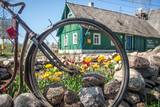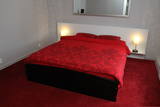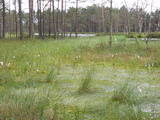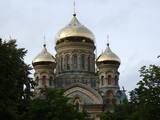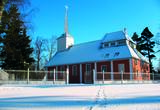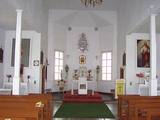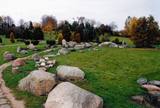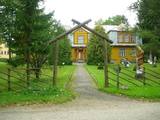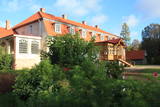| Nr | Nosaukums | Apraksts |
|---|---|---|
|
Viesu māja “Mesi Tare” piedāvā iespēju nakšņot Peipusa ezera krastā tradicionālā vecticībnieku mājā, kurā viss - sākot no mēbelēm līdz pat karotēm un dakšām - ir autentisks. Viesu rīcībā - visa māja un tās pagalms. Ir iespējams iznomāt laivas un velosipēdus, kā arī pasūtīt somu pirti vai dūmu pirti, ir arī baļļa. Vasaras sezonā viesiem ir iespēja atpūsties ezera pludmalē. |
||
|
Embūtes senlejas ekotūrisma taka iepazīstina ar ledāja veidoto Embūtes pauguraini, gravām (gravas un nogāžu meži – aizsargājami biotopi) un nozīmīgiem dabas un kultūras pieminekļiem – Embūtes pilskalnu, muižas, pils un baznīcas drupām, Kuršu virsaiša Induļa nāves vietu, Joda dambi, pļavām, skatu torni u.c. Apkārtnē izveidoti velomaršruti. Atrodas Embūtes dabas parkā. |
||
|
Kādreizējās Tabivere muižas vējdzirnavās darina dažādu garšu mājas alu. Dzirnavās iespējams degustēt alu kopā ar uzkodām, kā arī tiek rīkotas meistarklases. |
||
|
Viesu māja AMRAI atrodas Ventspilī, klusā, sakoptā rajonā, 6 km no centrālās pludmales un 2 km no savvaļas pludmales. Nakšņošanai piedāvā labiekārtotu divstāvu brīvdienu mājiņu ar diviem atsevišķiem numuriem, kā arī labiekārtotus 1istabas un 3istabu dzīvokļus privātmājā ar atsevišķām ieejām no pagalma. Vienistabas dzīvoklī ir duša, wc, virtuve,TV - vietējā, internets. Trīsistabas dzīvoklī ir džakuzi vanna, wc, virtuve, TV-vietejā, internets. Abos dzīvokļos ir veļas mašīna. Dārzā ir vieta rotaļām, batuti, grilli. Piedāvā galda spēles un spēles brīvā dabā- bezmaksas. Iespēja pasūtīt ēdināšanu, sarunāt auklīti, izīrēt divriteņus. |
||
|
Braucot cauri Kaives ciemam, var pievērst uzmanību Kaives muižas „atliekām”. Vietas vēsture ir sena, jo jau 1440. gadā Livonijas ordeņa mestrs piešķīra šeit īpašumu Johanam Kaivenam. Kungu māja gāja bojā 1905. gadā, bet pārvaldnieka ēku nopostīja 2. pasaules kara laikā. 1956. g. nodega kalte, bet pirms trijām desmitgadēm - muižas krogs. Līdz mūsdienām palikusi tikai 1861. gadā celtā magazīna (sarkana ķieģeļu ēka) pakalnā un tai blakus esošais parks, kurā izveidots neliels skulptūru dārzs, estrāde un atpūtas vieta. |
||
|
Viens no lielākajiem Latvijas purvu masīviem starp Babītes ezeru un Olaini, kura lielākā daļa ir un joprojām tiek izstrādāta kūdrā. Relatīvi maszkarta ir purva ziemeļu daļa, kurā izveidojies izcils purva ezeriņu komplekss un sūnu purva ainavas. Cenas tīrelis ir arī viens no retajiem Latvijas purviem, kurā vienlaikus ir novērojama gan rietumu, gan austrumu tipa purva ainava. Nozīmīga vairāku aizsargājamu putnu sugu dzīves vieta. Cenas tīrelī 2007. g. ir izveidota dabas taka un skatu tornis.
|
||
|
Dievnams celts 1900. - 1903. g. bizantiešu stilā kā kara garnizona baznīca, kuras iesvētīšanā (godinot visu jūrnieku aizstāvi – Sv. Nikolaju) piedalījies cars Nikolajs II. Grezno ēku izlaupīja vācieši 1. pasaules kara laikā. Pirmās Latvijas brīvvalsts laikā katedrāle darbojās kā Liepājas garnizona Dievnams. Padomju armija tā telpas izmantoja kā sporta un matrožu kluba kinoteātri un noliktavu. Saglabājušies nostāsti, ka padomju zaldāti esot no fasādes svētbildēm lauzuši zelta mozaīkas gabaliņus. Tagad baznīcā saimnieko pareizticīgo draudze. Katedrāles celtniecībā izmantota unikāla nepārtrauktās betonēšanas tehnoloģija, tādēļ būves konstrukcijām nav atbalsta kolonnu, un to smagums ir balstīts tikai uz ēkas sienām. Tās notur četras krustojošās arku velves. Šobrīd Latvijā augstākā pareizticīgo katedrāle.
|
||
|
Romas katoļu Dieva Žēlastības baznīca 1998. gada 19. aprīlī – t.s. “Baltajā svētdienā” jeb Dieva Žēlastības dienā – tika iesvētīta Saulkrastu Romas katoļu Dieva Žēlastības baznīca. Celtnes garums – 24 m, torņa augstums – 16 m. Baznīcu projektējis arhitekts Jānis Šrēders. Dievnamā ir 300 vietu. Kristus tēls altārgleznā ir tāds, kādu to vīzijā 1931. gada 22. februārī Polijas klosterī redzējusi svētā klostera māsa Faustīna, un to veidojis mākslinieks Ēriks Pudzēns.14 gleznās pie baznīcas sienām attēlots ciešanu ceļš – Kristus krusta ceļš no notiesāšanas līdz augšāmcelšanās brīdim. Altāris būvēts no cēlkoka oša. 1998. gada 2. augustā pie Saulkrastu Romas katoļu Dieva žēlastības baznīcas tika iesvētīts 7,38 augsts krusts. Naktī šis krusts tiek izgaismots. Tas ir līdzinieks Golgātas krustam Jeruzalemē, pie kura bija piesists Jēzus Kristus. (Avots: Saulkrastu TIC) |
||
|
Saimniecība ir neliela un atrodas laukos, klusā vietā. Līdz ar to pilnīgi dabiski tiek nodrošināta mierīga un relaksējoša saskarsme un darbs ar zirgiem. Piedāvā izjādes ar diviem zirgiem, organizējam sacensības pajūgu braukšanā. Vasaras periodā nodrošina zirgiem pansiju. Atrodas tikai 4,5 km no valsts nozīmes A9 ceļa Rīga- Liepāja un 16 km attālumā no Rīgas Zoodārza filiāles „Cīruļi”. Vasarā ir ugunskura vieta, nakšņošanas iespējas teltīs. |
||
|
Apmeklētāju centrā var iegūt noderīgu informāciju un iepazīt ekspozīciju par Karulas augstienes veidošanās vēsturi, ezeru iemītniekiem un šejienes novada kultūrvēsturiskajām tradīcijām. Apmeklētāju grupas semināru zālē var noskatīties izzinošu prezentāciju. |
||
|
Strūžānu Vissvētās Trīsvienības draudzes katoļu baznīca
atjaunota un iesvētīta 1958. gadā. Tā kā padomju varas gados neļāva
būvēt torņus, ēka atšķiras no pārējām baznīcām ar beztorņu arhitektūru.
|
||
|
Vienas dienas ceļojums pa Soomaa nacionālo parku gida pavadībā, iekļaujot pārgājienu pa purvu ar speciāliem purva apaviem un izbraucienu ar kanoe. Sākumā ir pastaiga cauri mežiem, sasniedzot lielāko kūdras purvu Igaunijā – Kuresoo. Pēc tam pastaiga ar purva apaviem, izbaudot savvaļas ainavu, un pusdienas brīvā dabā. Ceļojuma nobeigumā relaksējošs izbrauciens ar kanoe laivu pa Soomaa upēm. |
||
|
Viena no Latvijas skaistākajām upju krasta promenādēm, kas atrodas Ventas lejtecē – Ventspils vecpilsētas ziemeļdaļā. Tā izdekorēta ar govju skulptūrām, pieminekļiem, strūklakām un ziedu kompozīcijām. Šī ir viena no populārākajām pilsētnieku un tās ciemiņu pastaigu vietām, no kuras paveras pilsētas ostas skati. Līdz pagājušā gadsimta vidum Ostas ielā atradās noliktavas jeb tā saucamie spīķeri, no kuriem daļa ir saglabājusies līdz mūsdienām. Ostas ielas promenādes sākumu tās austrumdaļā iezīmē Tirgoņu dārzs (pie tā meklējams Ventspils TIC) un Jūrakmens. |
||
|
Rīgas HES komplekss ir savienots ar Doles salas austrumdaļu. Rīgas HES ir pēdējā no elektrostacijām Daugavas HES kaskādē. Tās celtniecību uzsāka 1966. g., bet pirmo hidroagregātu iedarbināja 1974. gadā, tā projektēto jaudu sasniedzot divus gadus vēlāk. Rīgas HES uzstādīti seši hidroagregāti, kuru kopējā jauda ir 402 000 kW. No Rīgas – Daugavpils šosejas (A 6) labi redzamas Rīgas HES dambis. Rīgas HES dzelmē palika daudzi kultūras un vēstures pieminekļi, t.sk. Laukskolas apmetne, kas ir vecākā zināmā cilvēku apmešanās vieta tagadējā Latvijas teritorijā. |
||
|
Atrodas Mazā Subates ezera ziemeļaustrumu krastā.Dievnams celts 1685. – 1686. g. bizantiskā stilā pēc Prodes muižas īpašnieka H. F. Ostena - Zakena rīkojuma. Šī ir vienīgā Latvijas baznīca, kuras arhitektūra atgādina 17. gs. beigām raksturīgās ideālā protestantu dievnamu formas. Interesanti ir ēkas stūros izvietotie mazie tornīši. Dievnama iekšpusē atrodas bagātīgi ornamentēts un skulptūrām rotāts kokgriezumu ansamblis, t.sk. - 17. gs altāris, kancele un biktssols, kā arī 17. - 18. gs. mākslas darbi un 1682. g. atliets zvans. Jāpiemin, ka daļu no baznīcas interjera ir veidojuši Stelmužes koktēlnieku skolas amatnieki.
|
||
|
The distance from Riga to Tallinn is more than 300 km and it takes approx. 5 hours by bus. Therefore we suggest stopping on the way for a brief excursion to a herb farm and lunch in a country pub. This stopover is approx. 1.5 hours’ drive from Riga, just at that point when one needs to stretch one’s legs and enjoy a change of scene. The visit will give an insight in rural life and it may surprise visitors to learn how well Latvians understand nature, knowing and using herbs for food, health and beauty. After the excursion, the group will have lunch in a country pub serving meals made from locally grown ingredients. |
||
|
Salantu reģionālā parka (Salantu regioninis parkas) galvenās ainavas veidotājas ir Erlas, Minijas un Salantas upju senielejas, kas izteikti atklātajam apvidum piešķir zināmu “rozīnīti”. Parka teritorijā atrodas Lietuvā lielākais kadiķu mežs. Kadiķu audzes, kurās redzami ledāja atstātie laukakmeņi ir raksturīgi tikai šim reģionālajam parkam. Akmeņi neparastā veidā ir arī eksponēti Mosēdes (Mosėdis) pilsētiņā un Vilius Orvidas saimniecībā pie Salantiem. Kopumā parkā konstatētas 570 augu sugas un 793 dzīvnieku, t.sk. bezmugurkulnieku sugas. Salantu apkaimē ir saglabāts vietējais dialekts, tiek svinēti vasaras saulgrieži, bet vecākās paaudzes iedzīvotāji reliģisku svētku laikā pulcējas pie kapelām un dzied t.s. piekopj maija (Gegužinė) lūgšanas. Parka apmeklētāju centrs atrodas Salantos. |
||
|
Jegevas apriņķis ir cieši saistīts ar nostāstiem par igauņu tautas eposa varoni Kalevipoegu.Par viņa „darbiem” šodien „stāsta” zobens Kēpas upē, viņa atpūtas vietas, akmeņi, avoti, purvi, arkla dzītās vagas, zirga pēdu nospiedumi utt.Kalevipoega muzejā atrodas 12 tematiskās istabas, kurās var iepazīties ar dažādiem materiāliem par Kalevipoegu un Igaunijas kultūras mantojumu.Muzeja ēkas priekšā ir izveidots sendārzs ar eposa 17 varoņu koka skulptūrām. |
||
|
Oleru muižas vietas aizsākumi meklējami 16. gadsimtā, 17. gadsimtā te saimniekoja fon Engelhartu dzimta un no 1836. gada – fon Krīdeneru dzimta. Sākotnēji muižas apbūvi veidoja no koka celta kungu māja un saimniecības ēkas. Jaunu muižas centru uzcēla 18. gs. beigās agrīnā klasicisma stilā. Pēc agrārās reformas muižas dzīvojamā ēkā izvietoja pamatskolu. Oleru muižas kungu ēka cieta ugunsgrēkā 2000. g., taču pēc ugunsnelaimes tika uzsākta tās atjaunošana, kurā liels ieguldījums bija un joprojām ir biedrībai „Oleru muiža”. Kungu māja pazīstama ar agrā klasicisma sienu gleznojumiem, no kuriem unikāla ir t.s. „Medaljonu telpa”. Kungu māju ieskauj romantisks ainavu parks. Oleru muiža pazīstama ar kamermūzikas koncertiem. Netālu no muižas atrodas Oleru purvs ar laipu un skatu tornīti. Apmeklējums iepriekš jāpiesaka! |
||
|
Skaisti un iespaidīgi skati, īpaši – agrās rīta stundās uz Alūksnes vēsturiskajām vietām paveras no Tempļa kalna, Aleksandra paviljona, obeliska H. Fon Fītinghofa piemiņai un pieminekļa 7. Siguldas pulka karavīru piemiņai apkārtnes. Tempļa kalns, pilsdrupas, muiža un paviljons - kultūras pieminekļi.
|
||
